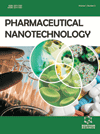
Full text loading...
We use cookies to track usage and preferences.I Understand

Diabetes is a chronic metabolic disorder that is characterized by high postprandial blood sugar levels and increased fasting, which disrupts physiological balance and causes organ damage. Owing to the global health risk of type 2 diabetes, natural remedies have shown promise as viable alternatives because of their outstanding antidiabetic properties. Nevertheless, the therapeutic use of these compounds is rather restricted due to their inadequate solubility, instability in the gastrointestinal tract, low absorption, and other related factors. Currently, the development of nanoscale systems is a notable approach to enhancing the delivery of phytochemicals. This study aims to investigate the advancements in drug delivery techniques using nanoparticles, with a particular focus on enhancing the effectiveness of herbal remedies in the treatment of diabetes. This study aims to enrich our understanding of nanotechnology's potential in enlightening drug delivery systems by employing database repositories like PubMed, Scopus, Google Scholar, and Web of Science. Based on their categorization and structure, nano-systems are classified into liposomes, nanostructured lipid carriers, phytosomes, niosomes, solid lipid nanoparticles, self-nano emulsifying drug delivery systems, and inorganic nano-carriers. This study intricately describes the formulation process, selection criteria, and mechanism of herb-loaded nanoparticles using an example of the pharmacokinetic and pharmacodynamic properties of antidiabetic herbal drugs. Researchers have proven that nano-formulations of herb-loaded antidiabetic drugs improve compliance and therapeutic efficacy by resolving pharmacokinetic and biopharmaceutical issues. We could expect the creation of nano-formulations to be a viable method for optimizing the therapeutic effectiveness of plant-produced antidiabetic compounds.

Article metrics loading...

Full text loading...
References


Data & Media loading...